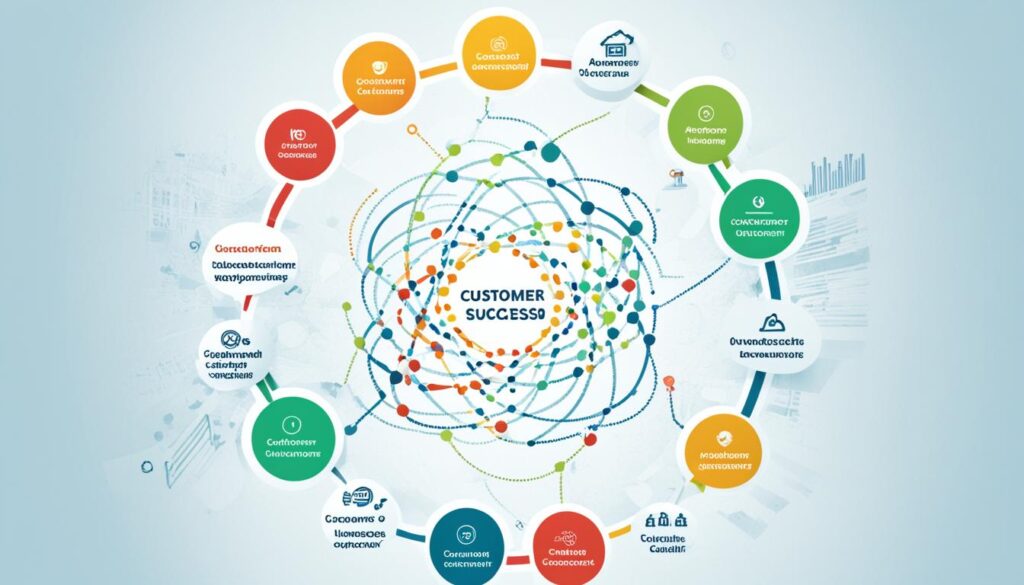Are you considering a career as a Customer Success Manager? If so, you’ve come to the right place. In this article, we will dive deep into the exciting world of customer success manager career paths and explore the various options and opportunities available to you.
Customer success manager (CSM) roles have witnessed remarkable growth and have become increasingly diverse in recent years. Whether you are interested in climbing the corporate ladder or making a mark as an individual contributor, the field of customer success offers a multitude of paths for professional growth and development.
From entry-level positions to senior leadership roles, customer success manager career paths are filled with potential and possibilities. By understanding the different career options for customer success managers and the steps needed to achieve career growth, you can pave the way for a successful and rewarding journey in this field.
Join us as we explore the exciting world of customer success manager career paths and equip you with the knowledge and insights needed to navigate your way towards a fulfilling and prosperous career in customer success.
Is a customer success career right for you?
Before pursuing a career in customer success, it’s important to assess if it aligns with your skills and interests. Customer success professionals play a vital role in ensuring customer satisfaction and driving business growth. To excel in this field, certain qualities and traits are valuable:
- Passion for customer experience: A genuine desire to help customers succeed and achieve their goals is crucial in customer success. You must be driven to deliver exceptional service and exceed customer expectations.
- Ability to sell without actively selling: Customer success is about building strong relationships and demonstrating the value of your product or service. You must be skilled at identifying opportunities to upsell or cross-sell without resorting to traditional sales tactics.
- Natural curiosity and problem-solving skills: Being naturally curious allows you to ask the right questions and uncover customer pain points. Strong problem-solving skills enable you to develop effective strategies to address those pain points and drive customer success.
- Experience managing customer relationships: Building and maintaining strong relationships with customers is a fundamental aspect of customer success. You should have experience in effectively managing customer relationships and fostering long-term partnerships.
- Ability to synthesize complex information concisely: In the customer success role, you’ll often need to communicate complex concepts or data in a clear and concise manner. The ability to distill information and convey it in a way that is easily understood by both technical and non-technical stakeholders is essential.

What does a customer success manager do?
As a customer success manager, your responsibilities encompass a wide range of tasks aimed at ensuring the success and satisfaction of your customers. By actively monitoring customer health scores, running playbooks, studying user behavior, managing customer onboarding, promoting retention and renewals, and boosting product usage and expansion, you play a vital role in supporting and enhancing the customer experience.
Your daily tasks as a customer success manager involve closely monitoring customer health scores to identify any potential issues or areas for improvement. This allows you to proactively address concerns, provide personalized assistance, and ultimately ensure the continued success of your customers.
Additionally, running playbooks specific to different goals and scenarios helps guide your actions and interactions with customers. By following established playbooks, you can effectively address customer needs, resolve challenges, and maintain a consistent level of service across the board.
Studying user behavior is another important aspect of your role. By analyzing customer interactions with your product or service, you gain valuable insights into their preferences, pain points, and overall satisfaction. This knowledge enables you to tailor your approach, anticipate customer needs, and offer proactive solutions.
Managing customer onboarding is essential to ensure a smooth and successful transition for new customers. By providing comprehensive guidance, training, and support during the onboarding process, you establish a foundation for long-term success and build strong relationships with your customers from the start.
Furthermore, a key part of your role involves promoting customer retention and renewals. By cultivating strong relationships, addressing customer concerns, and consistently delivering value, you can increase customer loyalty and drive renewals, ultimately boosting revenue and ensuring the long-term sustainability of the business.
Another aspect of your responsibilities is to actively promote product usage and expansion. By highlighting additional features and capabilities, offering training and resources, and showcasing the value of your product or service, you encourage customers to fully utilize and expand their usage, leading to increased customer satisfaction and business growth.

Why is customer success so in demand?
Customer success is experiencing remarkable growth, with a year-over-year increase of 34%. In fact, 72% of customer success positions are concentrated in the SaaS and IT industries. The demand for customer success professionals is skyrocketing due to the tremendous value they bring to companies.
Customer success teams play a crucial role in boosting customer lifetime value by ensuring clients achieve their desired outcomes. By actively engaging with customers, they improve retention rates and overall satisfaction. Furthermore, customer success professionals provide vital insights and feedback to internal teams, driving product improvements and innovations.
Customer success teams also play a pivotal role in building customer trust and guiding product usage. By assisting customers throughout their journey, they enhance user adoption and ensure clients maximize the value of their purchases. This, in turn, leads to increased customer loyalty and decreased customer acquisition costs.
“Customer success teams are the driving force behind a company’s ability to meet and exceed customer expectations while fostering lasting relationships.”
Benefits of customer success teams:
- Boosting customer lifetime value
- Improving retention rates and satisfaction
- Providing valuable insights to internal teams
- Generating trust and credibility with customers
- Guiding product usage and maximizing value
- Reducing customer acquisition costs

| Benefits | Impact |
|---|---|
| Boosting customer lifetime value | Increases revenue and long-term business growth |
| Improving retention rates and satisfaction | Enhances customer loyalty and decreases churn |
| Providing valuable insights to internal teams | Drives product improvements and innovations |
| Generating trust and credibility with customers | Builds strong and lasting customer relationships |
| Guiding product usage and maximizing value | Ensures customers fully leverage product capabilities |
| Reducing customer acquisition costs | Efficiently retains existing customers, lowering acquisition expenses |
Starting a career in customer success
To start a successful career in customer success, it is essential to develop the necessary skills and knowledge. Here are some key steps you can take:
1. Develop Technical and Communication Skills
To effectively support customers and ensure their success, it is crucial to have strong technical skills. Consider taking relevant classes or courses to enhance your technical knowledge in areas such as software, data analysis, and customer relationship management (CRM) systems. Additionally, focus on developing excellent communication skills, both written and verbal, as effective communication is crucial in providing exceptional customer service.
2. Network with Professionals in the Industry
Building a strong network is essential for finding job opportunities and learning from experienced professionals in the customer success field. Attend industry conferences, join customer success-focused communities, and engage with professionals on social media platforms such as LinkedIn. Networking provides valuable insights, mentorship opportunities, and access to job openings in the field.
3. Attend Customer Success Training Programs
Many organizations offer customer success training programs designed to provide individuals with the necessary knowledge and skills to excel in the role. Look for reputable training programs that cover topics such as customer success strategies, relationship-building techniques, customer onboarding, and retention practices. These programs can help you gain a competitive edge and demonstrate your commitment to professional growth.
4. Join Relevant Communities and Organizations
Becoming a part of customer success-focused communities and organizations allows you to connect with like-minded professionals, stay updated on industry trends, and access valuable resources. Consider joining professional associations, attending meetups, or participating in online forums where you can engage in discussions, learn from others’ experiences, and expand your professional network.
“Investing in your skills development and building strong professional connections are crucial steps towards establishing a successful career in customer success.”
By taking these actions, you can lay a solid foundation for a rewarding career in customer success. Remember, continuous learning and networking are keys to long-term success in this rapidly evolving field.
| Key Steps to Starting a Career in Customer Success |
|---|
| Develop Technical and Communication Skills |
| Network with Professionals in the Industry |
| Attend Customer Success Training Programs |
| Join Relevant Communities and Organizations |
Customer success career paths and hierarchy
Customer success career paths provide individuals with various opportunities to grow and advance in the field. Whether you are just starting your career or aiming for senior leadership positions, the customer success industry offers a clear hierarchy of roles and responsibilities.
Let’s explore the different levels and positions within the customer success career hierarchy:
Entry-Level Customer Success Positions
Entry-level positions, such as Customer Success Associates, Specialists, and Representatives, serve as the foundation for building a successful career in customer success. These roles often involve providing onboarding support, addressing customer inquiries, and ensuring customer satisfaction.
Technical Customer Success Positions
For individuals with a passion for technology and problem-solving, technical customer success positions offer an exciting career path. Roles like Customer Success Engineers involve working closely with customers to understand their technical requirements, troubleshooting issues, and providing customized solutions to drive customer success.
Management Positions
As you gain experience and expertise in customer success, you may progress into management positions. Customer Success Managers and Enterprise CSMs take on a more strategic role, overseeing a team of customer success professionals and ensuring the overall success of their assigned customer portfolio. Renewals Managers focus on renewing and upselling existing contracts, driving revenue growth through customer retention.
Senior Leadership Positions
At the top of the customer success career hierarchy, senior leadership positions provide an opportunity to shape the direction and strategy of customer success initiatives within an organization. Customer Success Leaders, Directors of Customer Success, Vice Presidents of Customer Success, and Chief Customer Officers play crucial roles in driving customer success at a company-wide level, aligning customer success goals with overall business objectives.
Now, let’s take a look at a visual representation of the customer success career hierarchy:
| Level | Positions |
|---|---|
| Entry-Level |
|
| Technical |
|
| Management |
|
| Senior Leadership |
|
As you progress through the customer success career hierarchy, opportunities for growth, increased responsibility, and higher salaries become available. It’s essential to set clear goals, continually enhance your skills, and seek out new challenges to pave the way for a successful customer success career.

Creating a customer success career path within your organization
Building a strong customer success team is essential for the growth and sustainability of any organization. To cultivate a talented and committed customer success team, it is crucial to create clear career paths within your organization. By providing opportunities for growth, promoting talent development, and retaining existing team members, you can ensure a thriving customer success department.
There are several strategies you can implement to create career paths in customer success:
- Hiring Externally and Internally: To diversify your talent pool and inject new perspectives into your team, consider both external and internal recruitment. Hiring externally brings fresh talent with unique experiences and skills, while internal promotions allow for faster growth and knowledge sharing. By strategically blending new hires and internal candidates, you create a balance that combines industry expertise with fresh perspectives.
- Evaluating Skill Sets: When assessing potential candidates, it is important to consider the specific skill sets required for customer success roles. Look beyond traditional qualifications and focus on abilities such as strong communication, problem-solving, and relationship-building skills. By identifying and nurturing these key competencies, you can shape a customer success team that excels in meeting customer needs and driving success.
- Opportunities for Growth: Provide avenues for growth and advancement within customer success. This can be achieved by offering additional training programs, mentorship opportunities, and cross-functional collaboration. Encouraging ongoing learning and development ensures that team members are constantly sharpening their skills and staying up-to-date with industry trends.
- Individual Contributors and Management Roles: Recognize that not all team members aspire to managerial positions. Offer career paths that cater to both individual contributors and those interested in management roles. This allows employees to choose the path that aligns with their strengths, interests, and goals.
Creating a deliberate approach to career pathing in customer success promotes retention and talent development. It shows your commitment to the growth and success of your team members, increasing their loyalty and dedication to the organization.
Remember, feeding your customer success team from other departments can also be an effective way to create career paths. Employees from various departments bring different skillsets, perspectives, and experiences to the customer success role. By offering opportunities for cross-departmental transitions, you tap into the potential of employees who are already familiar with your organization’s products, culture, and customers. This not only enriches the customer success team but also contributes to a collaborative and interconnected work environment.
Investing in talent development within your customer success team is a win-win situation. It not only enhances the capabilities and performance of your team but also fosters a culture of continuous learning and growth. By creating career paths, feeding from other departments, and retaining and growing existing team members, you establish a robust and thriving customer success department that drives customer satisfaction, retention, and business growth.
| Key Benefits of Creating Career Paths in Customer Success |
|---|
| Enhanced team performance and productivity |
| Increased employee loyalty and retention |
| Access to a diverse range of skills and perspectives |
| Promotion of continuous learning and development |
| Improved customer satisfaction and retention |
| Facilitation of smooth knowledge transfer and collaboration |
Conclusion
The customer success manager career path offers a wide range of opportunities for growth and development. With the ever-increasing demand for customer success professionals, the future of this career is exceptionally promising. By understanding the potential career paths and investing in skills development, you can elevate your professional journey in the customer success field.
Customer success managers play a crucial role in driving customer satisfaction and ensuring long-term success. As companies recognize the importance of retaining and nurturing their existing customers, the need for skilled customer success professionals continues to rise.
To thrive in the future of customer success careers, it is essential to stay updated on industry trends, embrace new technologies, and enhance your communication and problem-solving skills. By constantly honing your abilities and leveraging your passion for customer experience, you can position yourself for success in this evolving field.
FAQ
Is customer success the right career for me?
To determine if a customer success career is suitable for you, consider if you have a passion for customer experience, the ability to sell without actively selling a product, natural curiosity and problem-solving skills, experience managing customer relationships, and the ability to synthesize complex information concisely.
What are the responsibilities of a customer success manager?
A customer success manager is responsible for tasks such as monitoring customer health scores, running playbooks for specific goals, studying user behavior, managing customer onboarding, promoting retention and renewals, and boosting product usage and expansion.
Why is there high demand for customer success professionals?
Customer success professionals are in high demand because they bring value to companies by boosting customer lifetime value, improving retention and satisfaction, providing insights to internal teams, generating customer trust, guiding product usage, and reducing customer acquisition costs.
How can I start a career in customer success?
To start a career in customer success, it can be beneficial to take relevant classes or courses to develop technical and communication skills. Networking with professionals in the industry, attending conferences, engaging on social media, and joining relevant communities can also help in finding job opportunities and learning from experienced customer success professionals.
What are the different career paths in customer success?
Customer success career paths include entry-level positions such as customer success associates, specialists, and representatives. From there, individuals can progress to technical roles such as customer success engineers. Mid-management positions include customer success managers, enterprise CSMs, renewals managers, and senior customer success managers. At the top level, there are customer success leaders, directors of customer success, vice presidents of customer success, and chief customer officers.
How can I create a customer success career path within my organization?
An organization can create a customer success career path by hiring externally and internally. This allows for the introduction of new talent and faster growth through knowledge sharing. It is important to consider the skill sets required for customer success roles and provide opportunities for growth, both as individual contributors and in management roles.
